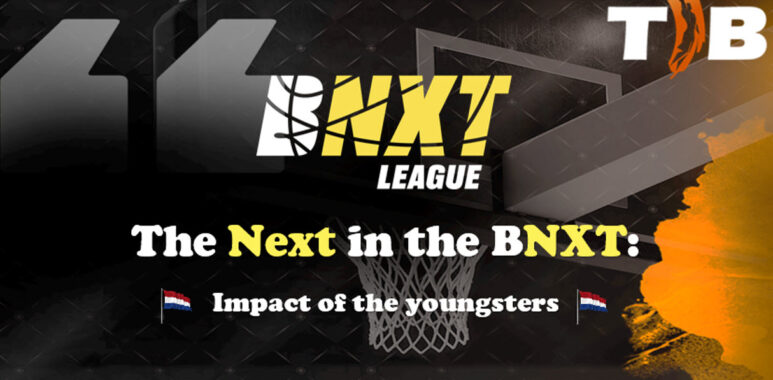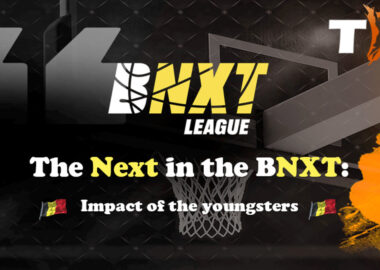
The Next in The BNXT: Impact of the youngsters (NL)
Self-Styled as the new up- and coming league with a focus on the development of young talent, the BNXT League has the lofty ambition of improving and securing the future of Belgian and Dutch Basketball. Now in its 4th season we at TIB figured it was about time to see exactly how this is playing out on the BNXT courts.
With an average age of 24.2 it is clear that the BNXT League is indeed a young man’s league compared to the top European competitions such as the Spanish Liga Endesa (27.8), the Italian Serie A (27.8), the French Betclic Elite (26.1) and the German BBL (25.3). Then again, with the Belgian and Dutch club budgets being as low as they are it is only logical that they can’t afford to sign the more established and experienced (read: better) players and therefore are forced to gamble on younger, inexperienced talent.
It must be said that the BNXT clubs have proven to be pretty adept at this difficult scouting exercise each season, producing a lot of talent that after their one season in the BNXT move on to bigger clubs and leagues (and bigger pay-checks). So, in that sense, the league does turn out to be a nice stepping-stone for younger players who are at the start of their professional careers. Unfortunately, these ‘one and done’-type players do not add much value to the sustained overall level of the league since they generally don’t hang around for more than one season. To lift the overall level of the league the BNXT clubs will have to look at the local Belgian and Dutch talents and invest in their continued development.
So, are the young Belgian and Dutch talents actually getting the opportunity to gain experience and further develop their game in the BNXT League?
To answer that question we will now look at each team and see what impact the youngsters have on their respective clubs. But before we can do that, we will first have to define the term ‘Youngster’. For the annual awards of ‘Youngster of the Year’, the league uses the criteria that a player needs to be 21 or younger (this year that means players born in 2003 or later), so for the sake of this article that is the criteria that we will use.
Now on to the overview of the Dutch teams.
Spoiler alert: it’s worse than on the Belgian side of the competition.
Dutch Teams:

One Dutch team that has fully embraced their role as a youth developing team is Prismaworx BAL, although we must add that it is out of pure necessity. With an overall budget that wouldn’t even cover a minimum wage for 14 employees in the regular workforce, BAL simply has no other option than to go for youngsters who are willing to play for basically three free meals a day and the opportunity to gain valuable experience on the BNXT League courts. With 11 youngsters on their roster BAL is easily the youngest team in the league with their average age of 20.9. Not surprisingly these youngsters are responsible for a league high 51.5% of the team’s statistical output. Equally unsurprising is that BAL is currently dangling on the bottom rung of the BNXT League totem pole with a 2-12 record. At TIB we definitely believe in giving the youngsters the opportunity to learn and gain experience, but without talented and experienced players next to them to guide and teach them, I’m really not sure how valuable this experience actually is. The 11 youngsters in question are Rene-Charles Louis-Therese (20), Lon Lican (20), Milo Hautekeet (20), Ade Afolabi (19), Bojan Tisma (20), Niels Van Holst (20), Renars Vogelaar (21), Dylan Quirijnen (?), Bink De Goede (17), Romano Sibilo (20) and Relja Varagic (?).


The second team on our ‘Youngster-Friendly’ ranking is QSTA United. With an average age of 22.8 (4th youngest in the league) QSTA has 5 youngsters on their roster who have already received playing time so far this season. Clearly QSTA has found a much better balance between youngsters and more experienced players than BAL, but unfortunately for them it hasn’t really translated into better results as they are also at the bottom of the standings with a 2-12 record and look like they’ll have to battle it out with BAL to avoid relegation at the end of the season. The 5 active youngsters on QSTA’s roster are Marko Saveljic (17), Florian Rijkers (19), Niels Van Hout (18), Tjall De Vaal (20) and Daniel Quincy Biliosa (20). Rijkers is by far the most established of the bunch as he receives 10.8 mpg in which he averages 2.8 ppg & 2.9 rpg. Together these 5 youngsters are responsible for 13.2% of the team’s statistical output.


Next up is Zeeuw & Zeeuw Feyenoord who are currently 15th in the BNXT League standings with their 5-8 record. Despite only having 3 players younger than 21 on the squad, Feyenoord is still one of the youngest teams in the league with their average of 23.7 (7th youngest in the BNXT). The 3 youngsters are Dion Turpijn (21), Noah Slingerland (19) and Jurian De Pater (20). Out of these 3 Slingerland receives the most playing time at 10.5 mpg, but unfortunately his actual impact on the court is rather limited. Same goes for the other 2 youngsters, giving them an overall impact of only 8.4% on the team’s statistical output.


As far as the youngsters are concerned, things go down hill quite rapidly from here on out as we now check out the Den Helder Suns. With an average age of 25 (6th oldest in the league) Den Helder has exactly one (yes, count them well, one) youngster who has received playing time so far this season. Quite impressively, that one youngster still manages to produce 5.8% of the team’s total statistical output. The one-man show that is called Matthijs Verhallen (21) is playing an average of 14.5 mpg in which he produces 4.2 ppg & 1.4 rpg for the Den Helder Suns who are currently nursing a 5-8 record, good for the 16th spot in the BNXT League standings. It might still be early in the season but I do believe the Dutch Youngster of the Year has already been found! I joke of course, but unfortunately there’s no one else who’s actually getting enough playing time to even be considered for that trophy.


On we go (try to ignore the slight hint of desperation in my writings). On to Donar Groningen. Hit with financial issues last season the amazing Donar fans have put the club on their shoulders and have carried them into the current season where they are now holding a 3-9 record and the 17th spot in the BNXT League standings. Not exactly the results those previously mentioned amazing fans were hoping for, I imagine. So, what of the local youngsters? Are they getting their fair share of opportunities with a club in a rebuilding phase? Well… no. Not really. With an average age of 23.3 the roster is amongst the youngest of the league (6th) but as far as 21 and younger goes, only 4 of them have received any playing time so far. The 4 being Edwin Nanninga (17), Lars Jung (20), Coen Gelling (19) and Dele Adetunji (21). Out of these 4 only Adetunji is getting a respectable amount of playing time with 11.7 mpg, but unfortunately he’s been seriously struggling so far on the offensive end.
Ah yes, I would almost forget, the overall statistical impact of the Donar youngsters: a whopping 5.4%… and there are still 4 more teams to go…


With a Belgian female coach on the sidelines and a decent 6-8 record (13th in the league’s standings) things can’t be all that bad for the Landstede Hammers, right? Well, seeing how far down on our ‘Youngster-Friendly’ ranking they are, the answer is pretty obvious. With an average age of 24.1 the Hammers are a fairly young squad (8th youngest in the league) but much like Donar Groningen, only a few of them are 21 years of age or younger. The 3 youngsters in question being: Jasper Olsthoorn (17), Kiron Issidorides (19) and Nino Vrencken (21). Those 3 players unfortunately receive very little playing time, giving them a combined impact of 4.3% on the team’s overall statistical output.


On to the biggest surprise of the still young season: LWD Leeuwarden. With an average age of 24.8 and their 9-5 record – good for the 4th spot in the BNXT League standings – things are running smoothly for LWD with attractive basketball and a nice cohesive unit. But as discussed before: having a bunch of ‘one and done’-type players on your roster is most definitely no guarantee for sustained success. This season LWD might as well finish as the top Dutch team, but if the majority of their roster leaves after the season, LWD might just as likely finish last next season. Continuity and investing in the local talent is the key. Looking at the local youngsters on the roster we can be pretty curt, there simply aren’t any. That is to say, they do have 2 youngsters who have seen some action so far this season but their combined impact comes up to 2.6%. So basically, no impact. The two youngsters in question are Bram Ter Weeme (18) and Thomas Van Der Geijn (21).


Oh how the mighty Heroes have fallen. Well, actually, after a pretty disastrous start of the season Heroes Den Bosch seem to have finally managed to shift into second gear and have been racking up some wins lately (4 wins in a row at the moment), giving them a 6-7 record in the BNXT League. Perhaps their slow start of the season can be explained by their second oldest roster in the league with an average age of 25.8 (only trailing the Kangoeroes with their average of 26.4). It’s just a simple fact of life that as you get older things go a little slower and your former explosiveness slowly but surely goes out the door (as I can definitely attest to). Although the Wen Mukubu’s and Lebron James’ of the world will probably dispute this. Anyhow, all kidding aside, the Heroes are on a run and are looking to build on their current momentum. Seeing how low they are ranked on our ‘Youngster-Friendly’ overview, you can already guess that their momentum won’t be carried further by any of their youngsters, since they only have 2 who have received any playing time so far with Thijs Beens (18) and Kyan Landveld (19). Both youngsters provide for a total impact of 1.4% of the team’s overall statistical output.


And finally, the reigning Dutch Champion and 2 time BNXT League Champions: ZZ Leiden. Leiden is another one of those surprises this season, but this one in a less positive way. With their 7-8 record at the moment Leiden has some way to go if they intend on catching up with the top teams in the league. Of course the season is still young and their current roster does seem to be capable of doing exactly that. Will the playing time of the youngsters increase throughout the course of the season is obviously my most urgent question. I guess we will have to just wait and see. But color me a pessimist, I personally wouldn’t hold my breath. Currently the roster has an average age of 24.7 with only 2 youngsters who have already received playing time so far this season, good for 1.2% of the overall statistical output. Those rare breed of actively playing Dutch youngsters are Luuk Van Zeil (19) and Ngouateu Wamba (19) respectively.

To conclude this overview: out of a total of 33 youngsters who have seen some action for the Dutch teams in the BNXT League, 9 youngsters have a respectable role and play more than 10 minutes per game. The 24 remaining youngsters are glorified first-row spectators who only see action when the game has already been decided and even then, only on rare occasions.
To read the Belgian side of the story, check out the article here.
I freely assume that the way I have written this article has slightly given away my own opinion on the situation but what do you guys think? Do the Dutch youngsters get enough opportunities in the league this season? Be sure to let us know in the comments!



